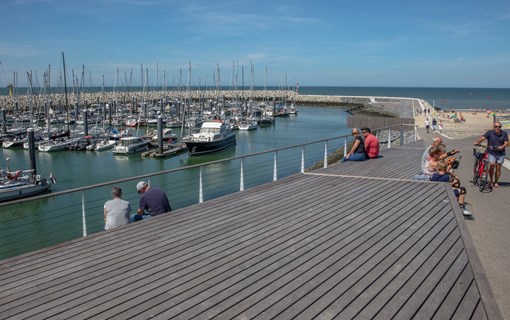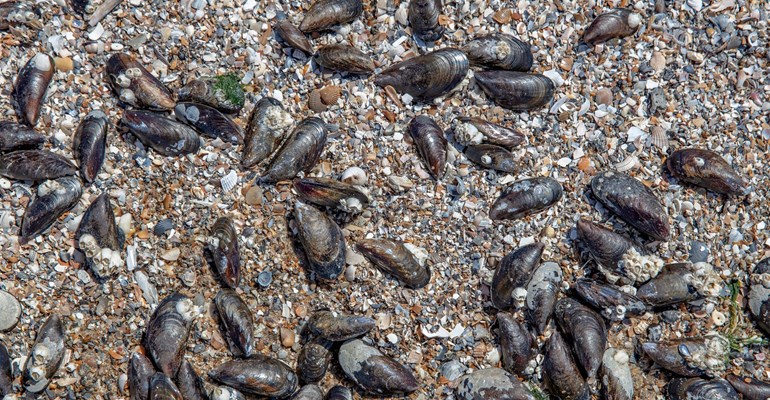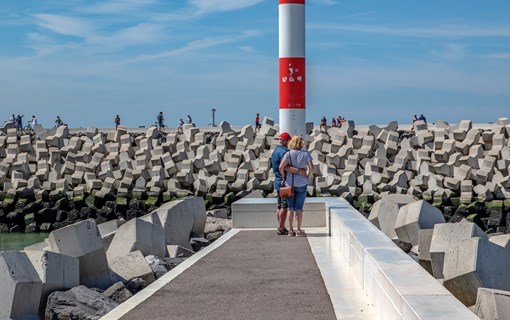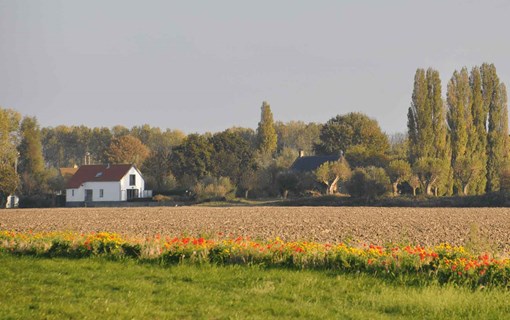
West-Zeeuws-Vlaanderen

West-Zeeuws-Vlaanderen
The tapestry of West Zeeland-Flanders spreads out between the Westerschelde estuary, the North Sea and neighbourly Belgium—a feast for lovers of endless beaches and nature. From the roiling dunes and dikes, waters, woodlands, ancient polders and pastures comes a culture and cuisine of the eclectic stacks of the Zeeuws table of life. Some call it ‘Bourgondisch’—Dutch, with Belgian tints but no English match, for the good life. By bike or on foot, dip into arty Groede, the cultural heritage of Aardenburg, iconic Sluis or your own find – it’s a kind of magic.
History
During the early Middle Ages, West Zeeland-Flanders became a part of the Frankish Empire, which had replaced the Roman Empire in what are now France and the southern Netherlands. The population was sparse, and the major settlement, Aardenburg, is today the oldest in Zeeland. Most relics found there in frequent excavations date from Roman times: its Sint Bavokerk was built after 925 by the monks of the Sint-Baaf abbey of Ghent. The oldest part features materials thought to come from the Roman Castellum constructed between 175 and 270 A.D.
Blossom time
The area started to flourish when a dam brought relief from regular flooding around the 13th century. Now the peat marshes could be dried and fired, releasing salt from the brine-soaked stalks. The resulting salt trade—a typical medieval livelihood—fed the growing demand of Flemish towns in particular. For a while. In 1515, following a resurgence of flooding caused by the peat depletion, such salt harvesting was banned.
Towns and villages
Slowly, and surely, towns began to take shape. The raising of dikes, and later making them stronger, was initiated by monks from the abbeys of Flanders, and gradually taken over by local government and private agencies. Then came the dams, then came the locks, then the fields filled with building deals. Then came the castles, farms, bridges, monasteries and convents, then came the roads and new communities like Cadzand and Groede, typical of the rich history of the towns and villages of West Zeeland-Flanders. In Aardenburg and Sint Kruis, artefacts of the first farmers to settle here have been found.
Then came the water
Zeeland-Flanders was long divided by De Braakman, a once sizeable sea inlet. Its name – ‘The Derelict Dude’ – is thought to come from its long period of disuse after the Romans were here. Left to its own natural devices, it was host to many a flood, and became tidal flats. Many villages in the western part were hardly more than islands, being engulfed often, and even drowning in the sea. The two floods of 1404 and 1421, both on 19 November, named after the patron Saint Elizabeth, were notorious for their destruction – as elsewhere in the Low Countries.
Staats-Spanish lines
One striking feature of the Eighty Years War from 1568 to 1648 was the wish of both parties – the Northern Netherlands (Dutch Republic) and the Spanish Crown – to erect the Staats-Spanish defence lines network. A complex system designed by the like-minded, it’s still well visible in much of West Zeeland-Flanders. Unarmed and unarmoured, you can explore it today by bike and by foot and end up enamoured.
Then came the province
Until 1600, Zeeland-Flanders was in the County of Flanders, called ‘Vlaanderen’ after a fusion of medieval Flemish for ‘plain’ and ‘wander’. The States General of the Dutch Republic ruled it until 1795. In July 1814, it joined the province of Zeeland.
Nature’s way
The battle, our struggle, with water has shaped more than our character: its marks are ubiquitous in our landscape. It forms our picture for you to complete. Imagine. Creeks and inlets are like pastel paints. Our fabulously wide beaches are massive canvasses, lofty poplars on dikes are the handles of your brushes, the knarled willow trees along rambling lanes their bristles, and the moist meadows, mudflats, marshlands and dunes are … up to you. To guide you, three key natural areas: Het Zwin, the Verdronken Zwarte Polder and Waterdunen. Try it. We were taken by a picture of you.
Paradise of birds
Between Breskens and Groede, you can’t miss the ‘Nieuwe Sluis’ – the oldest cast-iron lighthouse in the country. It’s perched alertly on the seawall ever since 1867. Other visitors, feather cast, have been coming here for longer. All sorts of migratory birds heading from Africa to the Arctic alight here before crossing the Westerschelde: not far from the ‘Nieuwe’, our own bird counters have a post. Whether you’re on a seawatch count, or are a passing admirer this is the place to be.
Recreation spot-on
When you live with water, life has to be functional, as well as fun. In our current dune and coastal defence upgrade—resilient enough for a once-in-4000-years ‘super storm’—we’ve included four recreation spots. Water retention buffers and aquaculture test beds can be cool too: just ask the birds, and the bees, and the bushes.
A white flag atop wooden masts will help you locate the spots – they blend in so well. One such is Waterdunen, also the entire project name. At the Herdijkte Zwarte Polder, a re-poldered nature reserve, the sea vista from the lookout post is breathtaking. The playground at Nieuwvliet-Bad makes us all young(er) again. But the awesome-est place is the 22nd century open-air theatre at Groede: hats off to that roof! Even bicycles stand in line to take a selfie, the sea as backdrop.
Sights, to sea
There’s always loads to do and see in West Zeeland-Flanders – swallowed with lungful’s of healthy Zeeuws air. Flex yourself on the water, have a lazy sandy afternoon on the beach. Take the sea-side path on foot, or on your bike, or pedal more lightly inland over meadows and polders. Or shop til you drop in Sluis and browse through our cultured museums. All yours for the taking.
Very Westerschelde, very ferry
Not many shipping routes in the world are busier than the Westerschelde. The nippy foot and bike ferry will bring you (and many other appreciative visitors) safely across in less than half an hour, past the ocean-going freighters, over to the ‘other side’ — the notion of the ‘overkant’ is one of the fundaments of Zeeuws society. Before the Westerschelde tunnel opened in 2003, a more ponderous car ferry plied the exclusive route between our Breskens in West Zeeland-Flanders and Walcheren’s Vlissingen. Sea gulls, sand banks, white-capped waves, blue (or grey) skies – no crossing is the same. Always another ‘overkant’.

